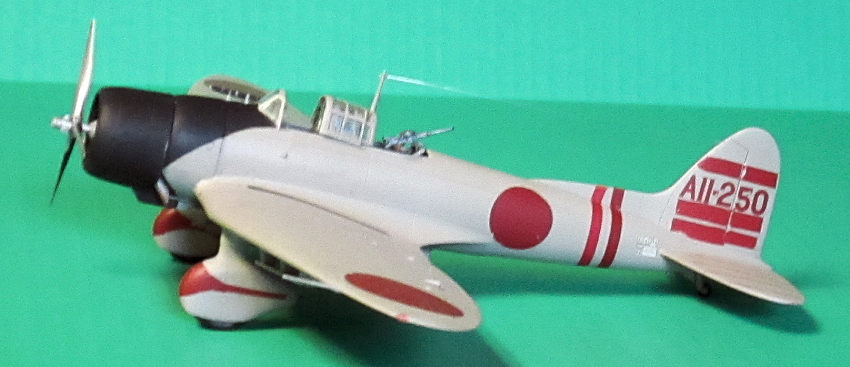
| KIT #: | Jt 55 |
| PRICE: | $35.00 |
| DECALS: | Two options |
| REVIEWER: | Dave Cummings |
| NOTES: |

| HISTORY |
For George “Wheaties” Welch and Ken “Grits” Taylor, life had turned swell following the struggles of schooling, military drill, and intensive flight training. As recently minted 2nd Lieutenants they were now full-fledged officers and gentlemen. Dressed in formal attire, they enjoyed some of the elegant nightlife Honolulu had to offer such eligible young men on a Saturday night. Following dinner and dance they joined an all-night poker game.
Sunday, 7 December 1941, 230 miles northeast of Oahu, LT Saburo Makino stands near his plane on the Aircraft Carrier Kaga. He was sweating out the hour delay between the 1st Attack Wave that had taken off at 0600 and the scheduled 0700 take-off time for the 2nd Attack Wave with his squadron. If there would be a second wave. The declaration of war that was to be delivered to the Americans shortly before the attack should give them little time to prepare. But Squadron Leader Makino was a wizened veteran of the China war who understood how the best made plans often went awry. If the first wave ran into an ambush of alerted American fighters and anti-aircraft, there may not be a second. He gazed at the excited faces of his young pilots, visibly itching to jump into their D3A-1 dive bombers to strike a glorious blow for their Emperor against the enemy. Hopefully the 1st Attack Wave would catch the Americans off guard and succeed. If they failed to inflict serious damage to the American air bases Makino had no illusions about what awaited them. There would no surprise advantage for the 2nd Attack Wave. From the bridge far above, a ship’s officer leaned out a window to yell below, “TORA, TORA, TORA!” The signal flags to prepare for launch were hoisted up the halyard. They had done it! As squadron Leader he strived to remain stern as he faced young grinning faces. “You will all do your duty for the Emperor, man your planes.” LT Makino went through the start-up procedure for his D3A-1. As the aircraft in front of him began its take-off roll he taxied into position. At 0715 he got the go signal and led his squadron into the air.
The poker game broke up a little past dawn. George Welch and Ken Taylor were driving back to their quarters when swarms of airplanes swooped down on Oahu. Concussive explosions, smoke columns rising high into the air, orange flames. They were dumbfounded at the sight of smoke and flame rising above the Wheeler Field flight line as strafing Japanese Zeroes swarmed above. It was obvious that the 15th Fighter Group was not going to get into the air from Wheeler. Reaching the same conclusion the two men rushed into their quarters to a telephone. At the little Haleiwa airstrip outside Honolulu the 47th Squadron maintained some old C model P-40s and P-36s for training. Welch called Haleiwa and told them to get two P-40s armed and ready. Then they jumped into Taylor’s Buick for the ten mile journey. Approaching speeds of 100 mph at times, they were twice strafed by Zeroes which missed the speeding auto.
Saburo Makino circled the Kaga until his squadron
was formed up then set course for Oahu. Radioman / Gunner, CPO Sueo Sukida
checked his notes from the early morning briefing. He tuned the RDF radio to
pick up Honolulu radio station KGMB. Japanese Intelligence knew this station
made frequent all-night broadcast specials to serve as a navigational beacon for
aircraft flying in from the states. The first wave, taking off in darkness, had
used it to home in on Honolulu. There was no music coming from the station now,
only excited chatter reporting the attack. He relayed to his pilot, “I have the
radio signal, steer 247 degrees.”
The first wave, taking off in darkness, had
used it to home in on Honolulu. There was no music coming from the station now,
only excited chatter reporting the attack. He relayed to his pilot, “I have the
radio signal, steer 247 degrees.”
Ken Taylor’s Buick slid to a stop and the two pilots ran to the waiting P-40s being attended by ground crew. Strapping into their seats they were informed that there was no .50-calibre MG ammo available at Haleiwa. Only the four wing mounted .30-calibres were loaded. Welch held his thumb up and when Taylor returned the good to go signal he gunned the P-40 onto the grass runway without pause. Gear up, flaps up, they strained for altitude. Almost immediately Welch spotted a dozen aircraft circling the Marine airfield at Ewa. “Hey Grits, I see Jap bombers down there just like sitting ducks.” The novice fighter pilots simply joined in the formation of circling Val dive bombers and picked their targets. Welch lined up a Val in his sights and fired a long burst. One of his wing guns jammed but the other three sent the Val tumbling towards the ground trailing smoke. Taylor fired at his target until it exploded in flames and rolled over. After watching his first kill plummet to the ground Welch pulled the P-40 out of its dive and into a wide loop to get behind another Val. Firing long five second bursts that Val began smoking and losing altitude. Taylor joined the fight but the bomber, flown by Hajime Goto, was already dropping towards the beach and Welch was credited with the kill. The Duo continued their swirling dogfight with the Japanese squadron, getting hits on several more Vals. Then, out of ammo, they set course for Wheeler. Dodging bomb craters and wreckage littering the grass field they landed and taxied towards the flaming hell of the flight line. Welch grimaced at the wreckage of the 15th Pursuit Group’s brand new P-40Es.
Passing the Koolau Mountains, Pearl Harbor came into view. Saburo Makino saw the thick smoke rising above the harbor which could hinder target identification. He checked again the aerial photo on his knee clipboard. His target, the USS Nevada, and its berth location in battleship row was circled in red. He noted angry puffs of anti-aircraft fire bursting over the harbor from the now fully alerted American defenses. He scanned the skies for American fighters, nothing. He grinned as many of his imagined fears were allayed. He thumbed the radio button, “1st Squadron, attack formation.” Through the smoke below he saw that the berth where the Nevada should be moored was empty. Where was she? Even had she been sunk the battleship would still be visible settled into the shallows. There, the white line of a ships wake leading across the harbor, at its point the large squat shape of a battleship. The Nevada had slipped her mooring and was underway. Makino saw she was moving slow as the ship was undoubtedly still building steam. Black smoke indicated she had been hit. But she would soon be at maneuvering speed making her a much more difficult target. “1st Squadron, that ship underway is the Nevada, follow me.” As the battleship disappeared under his nose Makino rolled into a dive and lined it up in his bombsight. AA tracers from the fleeing Nevada flicked by him. He waited until dangerously low to assure a hit and released his bomb. Raising the dive brakes he pulled out and throttled up for altitude. He circled once to watch the remainder of his squadron pummel the fleeing battleship. Water geysers leaped from the ocean from near misses and bright orange flashes signaled direct hits. Not bad he noted with pride, could have been better, but against a moving target, not bad. He watched with satisfaction as the mortally wounded behemoth turned hard left. He figured her captain would not want to risk sinking in the channel which would block the harbor. She was now headed for land where the stricken ship would be beached to keep from sinking. Mission accomplished, Makino headed for the rendezvous’ point near Honolulu to reform his squadron and await the recall order.
George Welch cut the engine and leaped from the
cockpit. He yelled at some men to get ammo and rearm his ship. The group of
soldiers, blackened from smoke and exhausted, looked back with the vacant stares
of men in shock. They looked helplessly at the ammo storage building now burning
furiously. They wanted to run, the place could blow any minute. Then one young
soldier found that courage that defines the hero. He ran into the flaming
building and emerged, coughing, with a wooden crate of ammo. This act galvanized
the men into action. Luckily there was now a lull in the attack as the first
wave headed back for their carriers. A fire truck arrived and began spraying
water on the inferno. Ignoring the very real threat to their lives, the soldiers
took turns running into the inferno through the stream of water to retrieve
am munition. Welch and Taylor stood on the wings assisting the armorers with the
heavy belts of .50-calibre. Getting refueled would prove impossible, but they
didn’t have far to fly to find the enemy. They ducked as a Zero screamed
overhead hammering the area with 20mm shells. With a full load of ammo the
pilots climbed back into their P-40s to resume the fight. Welch ignored a
hysterical Major that had been demanding they stand down and disperse the
aircraft to protect them. Couldn’t that guy see there was a war on? Pursuits
were for Pursuing, not running away to hide. As they taxied away Taylor smiled
as a bedraggled sergeant snapped to attention to salute them. Gunning their
P-40s across the field, Wheaties and Grits took off just as a formation of the 2nd
Attack Wave bore in head on at them.
munition. Welch and Taylor stood on the wings assisting the armorers with the
heavy belts of .50-calibre. Getting refueled would prove impossible, but they
didn’t have far to fly to find the enemy. They ducked as a Zero screamed
overhead hammering the area with 20mm shells. With a full load of ammo the
pilots climbed back into their P-40s to resume the fight. Welch ignored a
hysterical Major that had been demanding they stand down and disperse the
aircraft to protect them. Couldn’t that guy see there was a war on? Pursuits
were for Pursuing, not running away to hide. As they taxied away Taylor smiled
as a bedraggled sergeant snapped to attention to salute them. Gunning their
P-40s across the field, Wheaties and Grits took off just as a formation of the 2nd
Attack Wave bore in head on at them.
Circling near Honolulu as his squadron reformed Saburo Makino looked down at Wheeler Field to see a couple American fighters taxiing for takeoff. Wheeler was a 1st Attack Wave target and there did not appear to be any other attackers over Wheeler at the time. They had no bombs but the D3As did have a pair of 7.7mm machineguns in the nose as well as a rear gunner. “American fighters taking off from Wheeler, I am attacking.” That half of the squadron already re-formed peeled off with their leader diving towards the runway of Wheeler Field.
Witnesses will recall seeing Taylor firing his guns while still in his takeoff roll. As soon as his P-40 had lifted from the runway Taylor was firing at a Val coming at him head on. They narrowly missed colliding as it flashed over him.
Lt. Makino had leveled off as his experience let him judge that the closing rate of the head on attack was not an optimal attack position. As the P-40s disappeared under his nose he wracked his aircraft into a split-S coming out behind and above the trail P-40 that had just lifted off. He hit the trigger button watching the stream of tracers stitch the American fighter.
Taylor instinctively ducked as bullets zipped through the P-40s aluminum skin with a whacking sound. He felt the armor plate behind his seat saving his life as it vibrated to repeated hits. In the same instant his canopy shattered and a bullet ripped through his left arm and hit the trim wheel. It exploded into fragments sending a spray of tiny shrapnel into his legs. He broke into a high G turn in an effort to lose his pursuer. But the P-40 was still gaining speed after takeoff and the Jap dive bomber stayed with him continuing to snap out bursts. In near panic Taylor realized this guy was no rookie. This was no game, the man behind him was going to kill him.
Saburo Makino remained latched to the American’s tail. The fighter was not yet fully up to speed and his aircraft still retained energy from the dive, he was quite capable of staying with his target. Though slow compared to fighter standards the D3A handled well and was quite maneuverable for such a large aircraft. He was amazed the P-40 had not yet gone down, he had seen the sparkles of hits on the cockpit where he was aiming. How much armor can an American fighter carry? He concentrated on keeping the enemy in his sights. After recovering from a brief red-out caused by the high G maneuver CPO Sukida had turned to look forward to see what his pilot was firing at. He then turned back to grasp his gun and check 6 o’clock. It was already too late.
As soon as Wheaties Welch heard the rumbling wheels go quiet as the P-40 lifted off he jerked the gear lever and began milking up his flaps. He lowered the nose to gain some speed then began a climbing left turn searching for Jap planes. Taylor’s P-40 came into view with a Val latched to his tail. Seeing Taylor was getting hammered Welch shoved his throttle to the stop and nosed down in an effort to get to his friend as quickly as possible. Lining his sights on the Val, Welch realized he was coming too fast and would overshoot. He cut the throttle and yanked the flap handle while trying to keep the decelerating P-40 lined up on the Val. He hit the trigger and hosed the Jap with .50-calibre fire.
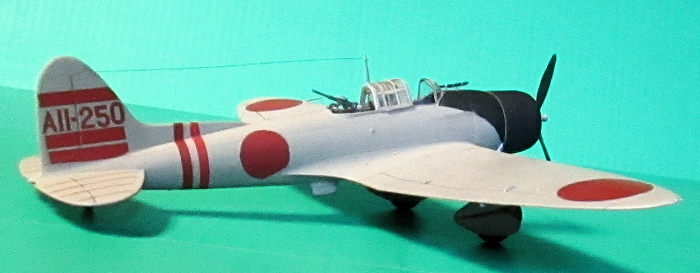 Makino knew it was the second American fighter. He
heard his rear gunner get off only a few shots before going silent. Then a
torrent of heavy machine gun fire tore into his aircraft. Flame streamed from
the cowling, pain as bullets tore into his body. He hoped the ancestors would
honor his arrival. He was barely conscious as his shattered aircraft flew itself
toward its final destination. Through dimming eyes he saw a house loom before
him. A lady wearing a white blouse was standing in the doorway, looking at him.
Makino knew it was the second American fighter. He
heard his rear gunner get off only a few shots before going silent. Then a
torrent of heavy machine gun fire tore into his aircraft. Flame streamed from
the cowling, pain as bullets tore into his body. He hoped the ancestors would
honor his arrival. He was barely conscious as his shattered aircraft flew itself
toward its final destination. Through dimming eyes he saw a house loom before
him. A lady wearing a white blouse was standing in the doorway, looking at him.
At 711 Neal Avenue in Wahiawa, Mrs. Paul Young opened her front door to watch the combat taking place over near-by Wheeler Field. She saw Welch’s P-40 shoot down a Japanese plane. Trailing smoke, it began its death dive. Then shock as she suddenly realized the descending airplane was heading straight for her house! She wondered what she should do. Should she run? Which way? It was coming so fast. With grateful relief she saw the big grey plane with gaudy red trimming float over her roof. There was a loud “WHACK” as it sheared off the top of the eucalyptus tree in her back yard, then cartwheeled into an adjoining pineapple field tearing into pieces.
Welch watched his third kill of the day smash into the ground and began an easy climbing turn towards the harbor scanning for enemy planes. A few minutes later he shot down a Zero over Barber’s Point, his fourth of the day.
Taylor shook off his near death experience and turned back into the fight. He bored straight in at a Jap bomber ignoring his wounds and the hits smacking into his plane from the rear gunner. His blood boiled with battle rage and he held the trigger down sending a long continuous stream of fire into the Val. He continued to attack mercilessly even though the Val, flown by Iwao Oka, had burst into flame. He continued firing as he followed it down until it crashed in a fireball. It was his second kill of the day.
(Authors note: This is a fictionalized account based on the historical events. It was a time of great confusion and many accounts, even those of Welch and Taylor themselves sometimes conflict.)
| THE KIT |
For a weapon having such a major
impact on the war, the D3A has not been as favored by model producers as has its
Axis stablemate, the Stuka. Fortunately, one that has is Hasegawa. Their Val has
been arou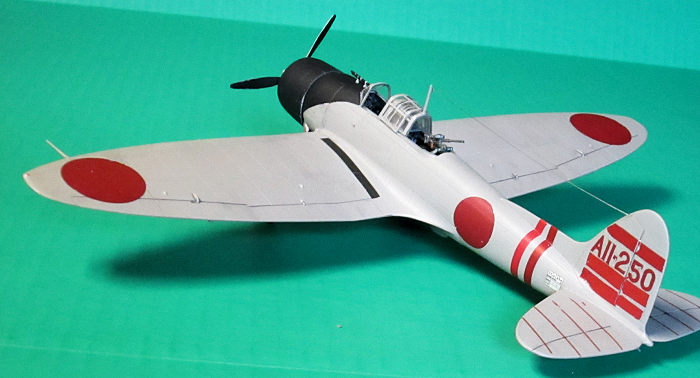 nd for many years but is still the “go to” kit for this airplane. The
sturdy box contains three sprues of light grey plastic and one clear.
Engineering, molding, and accuracy is typical Hasegawa quality. There is a one
piece closed and a multi-piece open canopy. Decals and painting instructions are
for a green painted Val from Soryu with gaudy leader striping and a gray with
black cowl scheme from Zuikaku. The sheet also includes a double set of red
numbers 1-10 and a variety of code letters to make pretty near any Pearl Harbor
Val if you supply the applicable striping. Instructions are adequate except
maybe for the complicated center bomb cradle assembly. There are those who
insist the cockpit is too basic and would benefit from an aftermarket set. But
for most of us not involved in contests I think it is plenty busy enough needing
only seatbelts.
nd for many years but is still the “go to” kit for this airplane. The
sturdy box contains three sprues of light grey plastic and one clear.
Engineering, molding, and accuracy is typical Hasegawa quality. There is a one
piece closed and a multi-piece open canopy. Decals and painting instructions are
for a green painted Val from Soryu with gaudy leader striping and a gray with
black cowl scheme from Zuikaku. The sheet also includes a double set of red
numbers 1-10 and a variety of code letters to make pretty near any Pearl Harbor
Val if you supply the applicable striping. Instructions are adequate except
maybe for the complicated center bomb cradle assembly. There are those who
insist the cockpit is too basic and would benefit from an aftermarket set. But
for most of us not involved in contests I think it is plenty busy enough needing
only seatbelts.
| CONSTRUCTION |
Paint colors of WWII Japanese
aircraft can be a jolly adventure in itself with all the ambiguity of 1st
person combat accounts. I settled on the “dark green” interior that I had
witnessed on actual pieces of wreckage from downed Vals (including Makino’s) on
display at the Pearl Harbor Museum. What shade of “dark green?” I think it’s
similar to that mysterious “Bell green” and went that route for the interior. I
used the supplied decals for the instrument panel and various radio faces. I
added seat belt decals fro m my stash. The cockpit is built up as a complete tub
assembly. The basic airframe of fuselage, wings, and tail planes is easily
assembled. You have the option to open the holes for the wing bombs at this
point. Fit is good except for that pesky wing trailing edge across the belly
seam which seems to bedevil most model kits, filler needed here. The top wing to
fuselage seam on mine needed a small bit of filler. With all the seams dealt
with I assembled and attached the gear spats. I found the wheels can be snapped
in later which eases paint masking. Next was the tail wheel and the dive-brake
hinges. This is a good point to paint the basic airframe. I masked the canopy
pieces with Tamiya tape and cut out the frames with a surgical blade. To prevent
paint overspray on the insides I stuck a little ball of Playdough into each
clear part. This also aids in painting the small pieces by sticking them to the
floor of the paint booth so they don’t go tumbling around when I blast them with
the airbrush.
m my stash. The cockpit is built up as a complete tub
assembly. The basic airframe of fuselage, wings, and tail planes is easily
assembled. You have the option to open the holes for the wing bombs at this
point. Fit is good except for that pesky wing trailing edge across the belly
seam which seems to bedevil most model kits, filler needed here. The top wing to
fuselage seam on mine needed a small bit of filler. With all the seams dealt
with I assembled and attached the gear spats. I found the wheels can be snapped
in later which eases paint masking. Next was the tail wheel and the dive-brake
hinges. This is a good point to paint the basic airframe. I masked the canopy
pieces with Tamiya tape and cut out the frames with a surgical blade. To prevent
paint overspray on the insides I stuck a little ball of Playdough into each
clear part. This also aids in painting the small pieces by sticking them to the
floor of the paint booth so they don’t go tumbling around when I blast them with
the airbrush.
| COLORS & MARKINGS |
The Hasegawa instructions offer their own
paint mixing formula which I assume is good. I tend to agree with those that
have settled on RLM-02 as possessing the equivalent gray with hues of tan and
green but think it a little too dark. I used Model Master acrylic, lightened up
some with white. No precise measure, just the “looks good to me” method. Thinned
for airbrushing the paint dried glossy en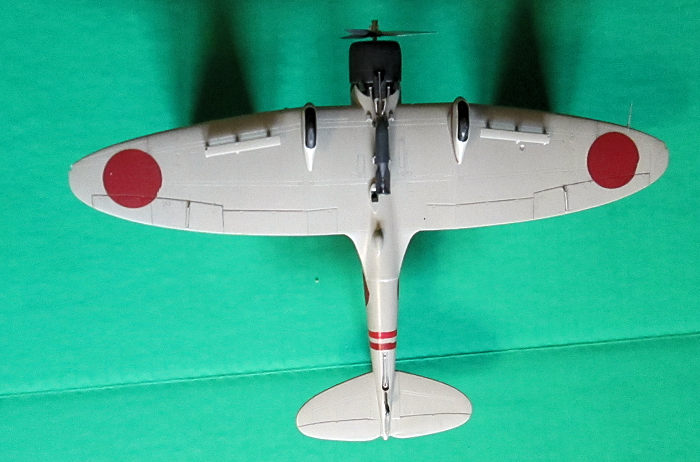 ough for decaling. I cut thin strips of Tamiya tape to mask the curving line of the black nose area then larger pieces
to mask around and covered the rest with a cloth to prevent overspray. I mixed a
small amount of blue to flat black in an effort to get that Japanese blue-black
look, but it just looks black.
ough for decaling. I cut thin strips of Tamiya tape to mask the curving line of the black nose area then larger pieces
to mask around and covered the rest with a cloth to prevent overspray. I mixed a
small amount of blue to flat black in an effort to get that Japanese blue-black
look, but it just looks black.
I was inspired to build this kit by the hoopla surrounding the 75th Anniversary of the Pearl Harbor attack in 2016. My attention was drawn to the well-publicized account of the Makino incident. As stated, the kit decal sheet allows one to cut and paste most any tail code. But I had to dig into the big decal scrap box for striping. With a little trimming I came up with about everything I needed in the matching Japanese brick red color, except for one fuselage stripe. Not wanting to put the project on hold I used one stripe of a different shade hoping you would not notice. The big Hinomarus on the wings needed Micro-Sol to settle into the engraving. I clear coated with AV Satin Varnish acrylic. Weathering was kept minimal as the Pearl Harbor aircraft are reported to have been in pristine condition.
| FINAL CONSTRUCTION |
The engine is just a single face piece but the sharp relief of the molding makes
it look every bit as good as a complete engine assembly when painted and cowled
up. The three piece cowling was assembled and painted then the engine glued in. Hasegawa uses those nylon bushings that allows you to just push the
prop in when you are ready. The wing tip navigation lights are provided on the
clear parts sprue. I put a small drop of green and red in their respective
openings and CA’d the tiny lenses in place (magnification req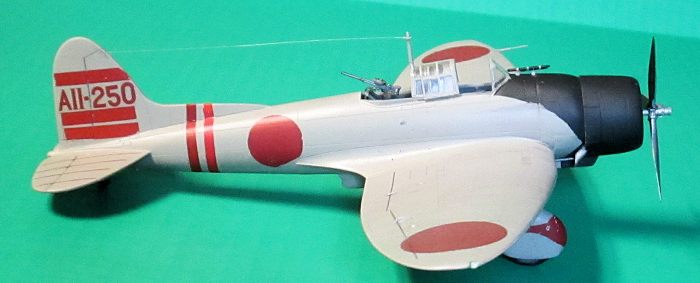 uired). Next the
things under wings were assembled. I attached the dive-brakes then assembled the
center bomb rack and trapeze assembly. The accurate depiction of these
mechanisms makes for a very fiddly assembly. The instruction drawing is OK but
test fit the tiny rack arms until you get how they relate to one another before
gluing (and don’t lose track that the forward and rear rack arms are different).
I advise gluing on the bomb before the parts dry completely to get everything
fitting together. Early on I had drilled the holes for the wing 66 Kg bomb
racks. So, I have found that researching a model subject and gathering pictures
and such is a big part of the modeling experience. Here I found that, having
done so, I should have actually looked at the stuff. The D3As attacking Pearl
did not carry the small bombs so I had to fill the holes I had drilled, sand,
and re-paint. Dummy. Lastly the canopy parts, rear MG, and antenna. I drilled a
tiny hole in the tail and CA’d a piece of 10 gauge music wire. When cured I CA’d
the wire to the antenna and when that cured I cut off the excess.
uired). Next the
things under wings were assembled. I attached the dive-brakes then assembled the
center bomb rack and trapeze assembly. The accurate depiction of these
mechanisms makes for a very fiddly assembly. The instruction drawing is OK but
test fit the tiny rack arms until you get how they relate to one another before
gluing (and don’t lose track that the forward and rear rack arms are different).
I advise gluing on the bomb before the parts dry completely to get everything
fitting together. Early on I had drilled the holes for the wing 66 Kg bomb
racks. So, I have found that researching a model subject and gathering pictures
and such is a big part of the modeling experience. Here I found that, having
done so, I should have actually looked at the stuff. The D3As attacking Pearl
did not carry the small bombs so I had to fill the holes I had drilled, sand,
and re-paint. Dummy. Lastly the canopy parts, rear MG, and antenna. I drilled a
tiny hole in the tail and CA’d a piece of 10 gauge music wire. When cured I CA’d
the wire to the antenna and when that cured I cut off the excess.
| CONCLUSIONS |
It was a pleasure to build a quality, hassle free, mainstream kit again. Especially after recently taxing my patience with a couple of those East European short run type kits. Out of the box the Hasegawa Val builds into an excellent replica. It is a trouble free build that even beginners should have little problem with.
| REFERENCES |
WWW.Wkipedia.com, WWW.Japanese-Aviation and More.com, WWW.Japanese Aviation Forum.com, WWW.Alpha Industries.com, WWW.Aviation-History.com
23 February 2017
Copyright ModelingMadness.com. If you would like your product reviewed fairly and fairly quickly, please
contact
the editor or see other details in the
Note to
Contributors. Back to the Main Page
Back to the Review
Index Page
Back to the Previews Index Page